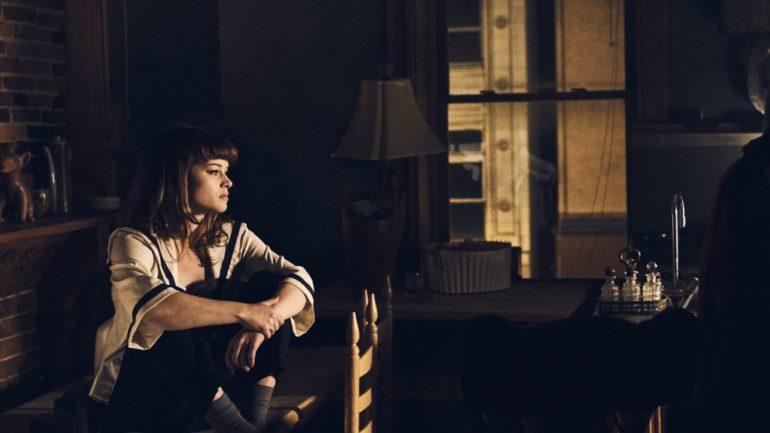Film Review: ‘Pretenders’
By Mark Keizer
LOS ANGELES (Variety.com) – At the beginning of Bernardo Bertolucci’s “The Dreamers,” his 2003 tribute to the French New Wave, Matthew, the naïve American studying in Paris, refers to true lovers of cinema as “the insatiables.” James Franco, with his 150 acting credits, 39 directing credits, 25 writing credits, and single credit as “boom operator,” is one of the industry’s most insatiable insatiables. So it’s fitting that his peripatetic career has led him to direct “Pretenders,” essentially a remake of “The Dreamers,” that combines Bertolucci’s decadent appreciation of New Wave cool with the love triangle from François Truffaut’s 1962 touchstone, “Jules and Jim.”
Moving the action to 1980s New York adds an urban-contemporary feel and an identifiable environment for events to unfold. But while the film’s sense of experimentation carries a fair amount of intrigue, it traps its central threesome in an Easter egg-filled intellectual exercise punctuated by melodramatic strokes. It’s skillful enough to tickle the mind and the emotions but not effective enough to fully engage them. Residual goodwill from Franco’s last relatively high-profile directing effort, 2017’s delightfully odd “The Disaster Artist,” should help North American distributor Cleopatra Entertainment reel in a smattering of curious moviegoers after which it’s off to VOD.
Resembling a less pouty Michael Pitt, who played Matthew in “The Dreamers,” Jack Kilmer is Terry Lamm (his last name a clue to his temperament), a sensitive Baltimore transplant studying film in New York in 1979 and first seen at a screening of Jean-Luc Godard’s “Une femme est une femme.” Afterward, his unsuccessful attempt to pick up a beautiful actress outside the theater is noticed by fellow student Phil (Shameik Moore), a swaggering photographer who offers to help Terry track her down. When Terry sees her outside the same theater some days later, he makes his move. Her name is Catherine (Jane Levy), the same as Jeanne Moreau’s character in “Jules and Jim.” Soon Terry wins Catherine’s heart but Phil, initially supportive of his friend’s quest, won’t let Terry have Catherine all to himself.
Franco, working from a script by Josh Boone (“The Fault in Our Stars”), sets up the possibility of a love triangle filled with gamesmanship and heartache. Terry is inexperienced and shy, expressing his love for Catherine by writing a script about how they met. She is the physical embodiment of everything he’s fallen in love with onscreen. Phil is the opposite, a naughty boy using his photography as a pretext for getting women naked. Moore (Netflix’s “The Get Down”) modulates Phil like a pro, keeping him likeable but nevertheless a predator who knows how to catch his prey. Catherine, the star around which Terry and Phil orbit for almost 10 years, has a tougher skin and a more modern sense of her own agency than Truffaut and Moreau’s creation. For Catherine, Terry’s dewy romanticism is not as exciting as being pursued by Phil, who earns a shag in a public bathroom by playing to her ego, claiming he wants to have sex with her to “prove to myself that there’s nothing special about you.”
This promise of high-stakes drama is mostly fulfilled in broad strokes. While all three performers, especially Moore and Levy, register strongly, their characters remain soapy constructs in the service of French and Italian movie references. One wonders if Franco, whose quirky directing career suggests he hops aboard whatever odd project strikes his fancy, signed on so he could explore and better understand New Wave cinema by making a New Wave film of his own. If so, it’s a sincere but only fitfully successful undertaking, greatly enlivened by DP Peter Zeitlinger, a Werner Herzog regular, who tips his hat to New Wave pioneers like Raoul Coutard while updating the visuals with striking colors and sharp nighttime exteriors impossible to achieve in the ’60s.
When the action jumps to 1983, we learn that Terry has become a film critic, the pre-directing vocation of Truffaut and Godard. When frizzy blonde actress Victoria (a spirited Juno Temple) recalls his favorable review of her work, she dumps her producer husband (Franco, in a few scenes) and accepts Terry’s marriage proposal, one of a number of rushed and schematic developments meant to get us to the next heartbreak.
By 1986, AIDS becomes the trio’s main concern, introduced as a topical parallel to the 1968 riots that jolted the threesome from “The Dreamers” out of their torpor. Although the AIDS epidemic is too-heavy a narrative burden for this story, it does reveal that both Bertolucci’s erotic, disturbing love letter and Franco’s sporadically engaging attempt at a spiritual successor are ultimately about the same thing: lost innocence. The films that enraptured Terry and gave his young life meaning eventually must give way to the anxieties of the real world. He and Phil don’t yet understand that not only are films not real but a New Wave pixie dream girl who dances in a sailor cardigan like Anna Karina and sprints across a bridge like Jeanne Moreau isn’t real either.

